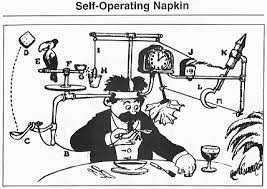I’ve spent some portion of my career with product designers. It has given me the opportunity to hang out with a lot of interesting people, whether they designed automobiles, airplanes, mobile devices, buildings, or even fashions.
Regardless of the product, when they approached design, they started on the outside–the parts visible to the customer and the parts the customer interacted with. They knew it was these parts of the product that attracted the customer and had the major impact on their experience both in buying and using the product. Most of the time, it was in the parts of the product the customer saw and interacted with that created great differentiation from the alternatives.
As an example, not long ago, I worked with one of the major mobile device manufacturers. Their new product design process was fascinating. The part of the design they kept internal was the outside of the product. They cared deeply about how it looked to the customer, the textures and tactile feelings of the device in the customer hands, the way in which the customer interacted with the device. These were the most important parts of the design and they needed to control that part themselves. Most of the design of the internals or guts of the device were outsourced to others. The client provided the specifications in terms of what the internals had to do and the specifications of the “package” these components had to fit in. They knew these parts, while necessary for the functioning of the device weren’t what caused the customer to buy.
With another technology vendor, we did user research on a new generation of products they were developing. While we worked with the design teams and customer groups to determine the functionality of the product, the most important part of the project was putting together mock-ups of the product. We tested alternative designs with hundreds of users, looking at various physical attributes of the device, the colors, finishes, the “buttons” and the overall user interaction. Part of what we assessed was how it looked to the customer and how it felt when they used it. This was the most important part of their design. After we determined what the “package” looked like, other design engineers worked on the internals, designing them to provide the functionality and to fit within our specified form factor.
Think, for a moment, about what attracts you to the products you buy. Do you buy a car because of how it looks, how it feels when you drive it, or what nuts/bolts/components are under the hood? Of your favorite mobile device, do you care about the RF shielding, the internal antennas, the resistors, capacitors, boards, or even the semiconductors.
Elegant, differentiated design is all about what the customer sees, how they interact with it, their experience, and how it makes them feel.
Which brings me to the key question of this post.
IF we know these things are so critical to the customer in what they buy, why do we constantly design our customer engagement processes from the inside-out? Why do we look at what’s easiest and most efficient for our internal operations, yet may not be easiest or most attractive to the customer? We focus on our own efficiency, and what is easiest for us. We fragment our approaches, so we often look very different to the customer depending on how they engage us. Marketing operates in their own silo optimizing their operations, sales in its and customer experience in it’s own. Each creating very different experiences and challenges to the customer.
It’s so ironic that the parts of our organizations that have the greatest impact on the customer are seldom designed from the perspective of the customer and how the experience they prefer.
Perhaps we should spend time with our product designers, perhaps we should learn what they’ve known for decades. What if we started designing our customer engagement processes–marketing, sales, customer experience from the outside working in, rather than what we currently do.
If we started our design of all our processes, working from the outside in, imagine what it might mean to our customers and the results we produce.

Hi Dave,
I haven’t read your blog in about two years, but it’s still as good as I remember it. I was very interested by your last four paragraphs, especially the second-to-last-one. Would it be all right to elaborate what a sales process designed to make things as smooth for the buyer as possible look like? It doesn’t have a be a real-world or even plausible example, I just like the way you think about things.
Joel, great to see you back here! Hope you stay and are a regular.
I’ll try writing a post about this, because it’s a great question. But some thoughts, most sales processes are inward-out oriented. But if we developed a process around the problems customers are trying to solve, we would be more helpful. We could look at helping the customer decide to change, learn about/define the problem, the questions they should be asking themselves, resources that should be involved in addressing the issues, etc. Our selling process should help guide the customer through the activities critical to successfully completing their buying journey.
I’ll write more in a post.